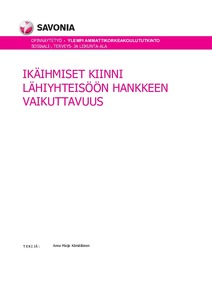Ikäihmiset kiinni lähiyhteisöön -hankkeen vaikuttavuus
Kämäläinen, Anna Maija (2020)
Kämäläinen, Anna Maija
2020
All rights reserved. This publication is copyrighted. You may download, display and print it for Your own personal use. Commercial use is prohibited.
Julkaisun pysyvä osoite on
https://urn.fi/URN:NBN:fi:amk-2020101921400
https://urn.fi/URN:NBN:fi:amk-2020101921400
Tiivistelmä
Pohjois-Savon Kylät ry käynnisti syyskuussa 2018 kolmivuotisen Ikäihmiset kiinni lähiyhteisöön -hankkeen, jonka tarkoituksena oli lisätä harvaan asutun maaseudun ikäihmisten hyvinvointia ja sosiaalisia kontakteja sekä turvallisen kotona asumisen mahdollisuuksia. Hanke on Sosiaali- ja terveysjärjestöjen avustuskeskuksen (STEA):n rahoittama ja se toteutetaan ajalla 1.9.2018–30.6.2021.
Työssäni selvitettiin Ikäihmiset kiinni lähiyhteisöön -hankkeen vaikuttavuutta sekä hankkeen palvelupäivien tavoitteiden toteutumista ensimmäisen toteutusvuoden ajalta saatujen kyselyvastausten perusteella. Lisäksi selvitettiin, onko maaseudun teiden huonolla kunnolla ja hoitamattomuudella tai julkisen liikenteen puutteella mahdollisesti vaikutuksia ikäihmisten terveydenhoitoon sekä hyvinvointiin. Palvelupäivien osalta arvioitiin myös ikäihmisten omaa kokemusta ja arviota hanketoiminnan vaikuttavuudesta ja tavoitteiden toteuttamisesta.
Ensimmäisenä vuonna palvelupäivissä tavoitettiin enimmillään 55 % ja vähimmillään 20 % kaikista eri kylillä asuvista yli 65-vuotiaista. Palvelupäivät tarjosivat monipuolista ohjelmaa sekä yhteisöllisyyden ja osallisuuden kokemuksia osallistujille. Hanke saavutti tavoitteensa tarjota tietoa, vinkkejä ja opastusta ikäihmisten toimintakyvyn, arjen turvallisuuden ja kotona asumisen mahdollisuuksien lisäämiseen. Palvelupäivien kautta koettiin kuuluvan enemmän kyläyhteisöön ja päivät toivat sisältöä elämään. Tapahtumapäivistä saatu palaute oli lähes poikkeuksetta hyvää ja pääsääntöisesti palvelupäivien sisältöön ja rakenteeseen oltiin tyytyväisiä.
Maaseutualueiden teiden huonokuntoisuudella, hoitamattomuudella ja kyytien puutteella oli jonkin verran vaikutusta terveyskeskus- ja apteekkiasiointeihin. Vastaajista 11 % oli joskus pitkittänyt terveyskeskus- tai apteekkiasiointejaan teiden huonokuntoisuuden tai kyydin puutteen vuoksi ja vastaajista 3 % kertoi olleensa ilman lääkkeitä samoista syistä. Vastaukset jakautuivat melko tasaisesti eri kylien kesken. Involving elderly people in the local community project is organized by Pohjois-Savon Kylät ry (Villages of North Savo). The purpose of the project is to bring wellness, social contacts and information on safer living at home to people who are living in the rural areas of North Savo. The project started in September 2018 and will last till June 2021. The funding for the project was granted by The Funding Centre for Social Welfare and Health Organisations (STEA).
The aim of this thesis was to find out the first year influence of the project and the aims of the service days. Data was gathered by structured questions and paper forms at service days. The purpose of the thesis was also to find out how lack of public transportation and rural roads which are not in good condition affect local people’s well-being and health. Elderly people were also enquired what they think about the effectiveness of the service days.
The participation in the service days ranged from the maximum 55 % to the minimum 20 % of all ageing people of the villages. As a result, the versatile programs of the service days have brought elderly people more social contacts and possibilities to be together and the programs have also provided information, ideas and help for safer and longer living at home.
The service days had been experienced to bring more activity and content to everyday living and give a stronger feeling of being a part of the village community. The feedback on the service days has been mainly good and elderly people have been satisfied with the content and structure of the service days. 11 % of the respondents felt that the access to a health centre or pharmacy in rural areas had been hampered due to the bad condition of the roads or the lack of transportation. There is no difference in the answers between the villages.
Työssäni selvitettiin Ikäihmiset kiinni lähiyhteisöön -hankkeen vaikuttavuutta sekä hankkeen palvelupäivien tavoitteiden toteutumista ensimmäisen toteutusvuoden ajalta saatujen kyselyvastausten perusteella. Lisäksi selvitettiin, onko maaseudun teiden huonolla kunnolla ja hoitamattomuudella tai julkisen liikenteen puutteella mahdollisesti vaikutuksia ikäihmisten terveydenhoitoon sekä hyvinvointiin. Palvelupäivien osalta arvioitiin myös ikäihmisten omaa kokemusta ja arviota hanketoiminnan vaikuttavuudesta ja tavoitteiden toteuttamisesta.
Ensimmäisenä vuonna palvelupäivissä tavoitettiin enimmillään 55 % ja vähimmillään 20 % kaikista eri kylillä asuvista yli 65-vuotiaista. Palvelupäivät tarjosivat monipuolista ohjelmaa sekä yhteisöllisyyden ja osallisuuden kokemuksia osallistujille. Hanke saavutti tavoitteensa tarjota tietoa, vinkkejä ja opastusta ikäihmisten toimintakyvyn, arjen turvallisuuden ja kotona asumisen mahdollisuuksien lisäämiseen. Palvelupäivien kautta koettiin kuuluvan enemmän kyläyhteisöön ja päivät toivat sisältöä elämään. Tapahtumapäivistä saatu palaute oli lähes poikkeuksetta hyvää ja pääsääntöisesti palvelupäivien sisältöön ja rakenteeseen oltiin tyytyväisiä.
Maaseutualueiden teiden huonokuntoisuudella, hoitamattomuudella ja kyytien puutteella oli jonkin verran vaikutusta terveyskeskus- ja apteekkiasiointeihin. Vastaajista 11 % oli joskus pitkittänyt terveyskeskus- tai apteekkiasiointejaan teiden huonokuntoisuuden tai kyydin puutteen vuoksi ja vastaajista 3 % kertoi olleensa ilman lääkkeitä samoista syistä. Vastaukset jakautuivat melko tasaisesti eri kylien kesken.
The aim of this thesis was to find out the first year influence of the project and the aims of the service days. Data was gathered by structured questions and paper forms at service days. The purpose of the thesis was also to find out how lack of public transportation and rural roads which are not in good condition affect local people’s well-being and health. Elderly people were also enquired what they think about the effectiveness of the service days.
The participation in the service days ranged from the maximum 55 % to the minimum 20 % of all ageing people of the villages. As a result, the versatile programs of the service days have brought elderly people more social contacts and possibilities to be together and the programs have also provided information, ideas and help for safer and longer living at home.
The service days had been experienced to bring more activity and content to everyday living and give a stronger feeling of being a part of the village community. The feedback on the service days has been mainly good and elderly people have been satisfied with the content and structure of the service days. 11 % of the respondents felt that the access to a health centre or pharmacy in rural areas had been hampered due to the bad condition of the roads or the lack of transportation. There is no difference in the answers between the villages.
